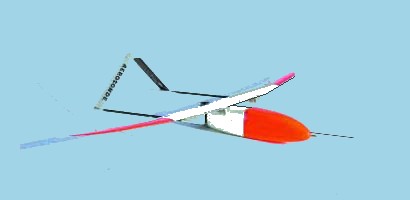![[Atlantic Oceanographic and Meteorological Laboratory]](../hrd_top_logo7.jpg)
| Staff | Data Center | Contact Information |
|
Aerosonde Observations in the Hurricane Boundary Layer EnvironmentCollaborating scientist(s):
First hurricane flight storyPower Point presentation on this Project Aerosonde first hurricane flight NASA's Wallops Flight Facility
Objective: It is believed that the payoff for such an effort would be significant and in some cases immediate. These benefits would include detailed documentation of a heretofore unknown region of the TC (Monitor and Observe) and simultaneously provide NOAA's Tropical Prediction Center (TPC) with real-time near surface wind and thermodynamic data within the TC environment. In addition, this effort will enhance our physical understanding of this critically important environment (Understand and Describe) and ultimately, provide improvements to future forecasts of TC intensity change (Assess and Predict). The primary objective of this project is to utilize the unique capabilities of the Aerosonde platform to document areas of the TC environment that would otherwise be either impossible or impractical to observe. While the main scientific goal of this project is to accurately document and improve our understanding of the rarely-observed TC boundary layer, an important (and immediate) additional benefit would be the real-time transmission of TC surface conditions directly to the TPC. In addition, detailed comparisons between in-situ and satellite-derived observations will also be possible. It is also envisioned that this unique data could ultimately be used to help initialize and verify both operational and research-oriented TC numerical simulations. When combined, these research and operational objectives match NOAA's Weather and Water stated outcome of "Increased accuracy and amount of lead time." Background: Simply stated, continuous observation of thermodynamic (temperature and moisture) and kinematic (wind) structure of the near-surface hurricane environment has never been documented in a hurricane. This environment, where the atmosphere meets the sea, is critically important since it is where the ocean's warm water energy is directly transferred to the atmosphere just above it. The TC surface layer is also important because it is where we find the strongest winds in a hurricane and coincidentally, the level at which most of us live (i.e. at/near the surface). As such, observing and ultimately better understanding this region of the storm is crucial if we hope to improve our ability to make accurate forecasts of TC intensity change. Enhancing this predictive capability would not only save our economy billions of dollars but more importantly it would save countless lives.
Method: The two primary scientific objectives would be to observe and better understand:
This experiment would also be in support of ongoing funded work by Cione under NOAA's 2003-05 Joint Hurricane Testbed (JHT) as well as the scientific foci associated with the African Monsoon Multidisciplinary Analysis (AMMA) field experiment scheduled for 2006.
This project is funded by the OAR Assistant Administrator's Discretionary Fund (AADF) project, the JHT, and NASA. This includes 75 Aerosonde flight hours as well as travel costs for the PI to the Aerosonde Wallops Island VA launch facility. Accomplishment:
Key references:
Last modified: 4/04/2005 |
![[OAR/DOC/NOAA Logos]](../oar_noaa_doc_logos3.jpg)







 While the successful utilization of the P-3 Orion and Gulfstream 4
aircraft have made NOAA a global leader in the area of hurricane
aircraft surveillance and reconnaissance, detailed observations of
the near-surface tropical cyclone (TC) boundary layer environment
have been elusive due to the severe safety risks associated with low
level TC manned flight missions. The primary objective of this funded
project is to address this significant observational shortcoming by
utilizing the unique low flying attributes of the (unmanned) Aerosonde
observing platform.
While the successful utilization of the P-3 Orion and Gulfstream 4
aircraft have made NOAA a global leader in the area of hurricane
aircraft surveillance and reconnaissance, detailed observations of
the near-surface tropical cyclone (TC) boundary layer environment
have been elusive due to the severe safety risks associated with low
level TC manned flight missions. The primary objective of this funded
project is to address this significant observational shortcoming by
utilizing the unique low flying attributes of the (unmanned) Aerosonde
observing platform.
 Under the second objective, the focus would be to document the TC
inflow layer out ahead of the storm, through the storm eyewall region
and into the eye and compare these findings with recent results from
Cione and Uhlhorn (2003), Wroe and Barnes (2003), and Cione et al (2000).
As mentioned previously, documenting and improving our understating of
this rarely observed high wind storm environment is critical if we are
to significantly improve future forecasts of TC intensity change.
Under the second objective, the focus would be to document the TC
inflow layer out ahead of the storm, through the storm eyewall region
and into the eye and compare these findings with recent results from
Cione and Uhlhorn (2003), Wroe and Barnes (2003), and Cione et al (2000).
As mentioned previously, documenting and improving our understating of
this rarely observed high wind storm environment is critical if we are
to significantly improve future forecasts of TC intensity change.